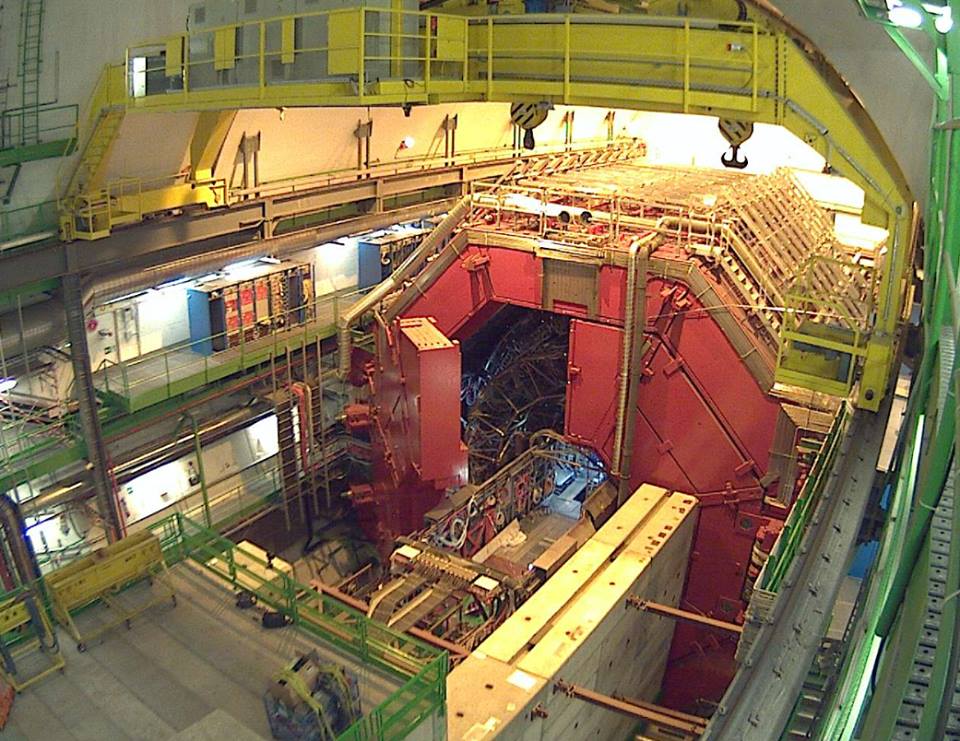"New" ALICE coming to life during LS2

The ALICE solenoid re-opens its door as the collaboration prepares for the detector upgrade planned for LS2.
At 6 a.m. on December 3, 2018, the LHC expert team switched off the engine of the biggest particle accelerator in the world, which will rest for the next two years before entering a new phase of operation. Starting in March 2021, in fact, the LHC will deliver collisions at increased luminosity, allowing the experiments to collect much more data in less time and, thus, to study rare phenomena.
The higher luminosity will certainly benefit ALICE, the LHC experiment dedicated to the study of the strong interaction and of the Quark-Gluon-Plasma (QGP), a state of matter which prevailed in the first instants of the universe and is recreated in droplets at the LHC by colliding lead ions. During Run 3, indeed, the interaction rate of lead ions will be increased to reach about 50 kHz, i.e. an instantaneous luminosity of L= 6x1027 cm-2s-1. This will allow ALICE to accumulate more than 10nb-1 of Pb-Pb collisions. Data samples of pp and p-Pb collisions will also be collected to measure the same observables in different interaction systems.
To exploit the extraordinary scientific potential of Run 3 and subsequent HL-LHC operations and to be able to study rare processes, the ALICE collaboration is currently implementing a major upgrade of its detector, data-taking and data-processing systems.
The current Inner Tracking System (ITS), which is located at the heart of the detector, will be replaced by a brand-new one composed of seven layers of silicon pixel detectors. A compact pixel sensor chip (ALPIDE), based on the Monolithic Active Pixel Sensors (MAPS) technology, has been developed for this upgrade. The new ITS will improve dramatically the resolution of the detector and its ability to reconstruct the particle trajectories and identify secondary vertices.
![]()
Mounting of a module of the New Inner Tracking System (ITS) of ALICE, which will be installed in the heart of the experiment in 2020
A novel Muon Forward Tracker (MFT), implementing the same custom ALPIDE chip, will also be installed in the forward region of the detector. Thanks to its excellent spatial resolution, not only will ALICE be more sensitive to several measurements, but also it will be able to access new ones that are currently beyond reach. A new Fast Interaction Trigger (FIT) detector will also replace three current forward detectors, with the aim of providing the minimum-bias trigger and excellent time resolution for identifying decay vertices.

ALICE Time Projection Chamber (TPC), the largest in the world at nearly 100 cubic metres, will also be upgraded during LS2.
The increased collision rate also requires a major upgrade of the ALICE TPC. The current detector is limited by its read-out chambers, which are based on multi-wire proportional chamber (MWPC) technology. Thus, they will be replaced with multi-stage gas electron multiplier (GEM) chambers, the development of which has required intense R&D activities. The TPC upgrade will increase the read-out rate of the detector by about two orders of magnitude, while preserving its excellent tracking and particle identification capabilities.
The new common online-offline (O2) system will transfer data from the detector directly to computers either continuously or with minimal trigger requirements. A new computing facility for the O2 system is being installed at the experimental site.
Whereas the machine will sleep, this long shut down period will be nothing but quiet for all the engineers and physicists who will work on a tight schedule to make the ALICE experiment ready for the next challenges.
